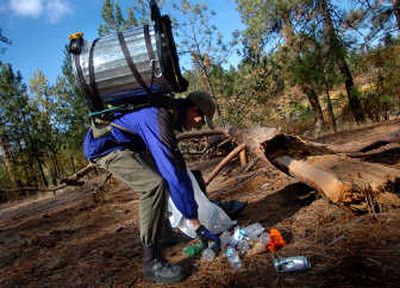Volunteers help stop flow of trash

Connor Abbott was making the best out of a messy situation Saturday.
Armed with a blue trash bag, the 9-year-old Otis Orchards boy slid sideways down a dusty embankment under the Sunset Highway Bridge to join about 750 others who volunteered to pick up trash for the 5th Annual Spokane River Cleanup.
“My sister and I are having a contest to see who can pick up the best stuff,” Abbott said. “I’m going to win.”
Cailey Abbott, 7, hadn’t really found anything of interest, but she did stuff plenty of cans, bottles, and fast-food wrappers into her own trash bag.
Fanning out from High Bridge Park along the river north to the TJ Meenach Bridge, volunteers could be seen scattered along the banks clearing waste left behind by discourteous individuals.
If last year’s annual event – organized by the Friends of the Falls – is any indicator, the volunteers would end up hauling out about 9,000 pounds of trash from areas along the river gorge.
Volunteers also competed for prizes given to those who found the most interesting pieces of garbage.
“It’s like a treasure hunt for trash,” said John Snyder, 38, whose two children, ages 3 and 7, were helping collect garbage under the Sunset Bridge, along Latah Creek.
But not every carelessly tossed item was considered a treasure.
“My son picked up a needle before I could get to him,” Snyder said. Fortunately the hypodermic needle was capped. Snyder said he also found a couple of condom boxes.
The unsavory finds were not unusual for the 200-acre High Bridge area, where drug dealing and illicit sex have been known to take place.
But that’s changing. With the development of a white-water park on the river west of downtown Spokane, the Friends group hopes to attract more people to the area and push out the shady element.
“A lot of what this is about is to make this area more attractive,” said Steve Faust, executive director of Friends of the Falls. “The more people you get to come here and use this area, the perception that it’s unsafe will change.”
Before electricity-generating dams, the portion of the Spokane River near High Bridge was boasted as one of the area’s largest salmon runs and was considered sacred by Native American tribes who came from as far away as Montana to fish there.
“This is one of the most beautiful parks in Spokane and one of the most neglected,” said Karen Jurasin, who was leading a team of people collecting garbage at Saturday’s event, and who also volunteers with the Inland Northwest Trails Coalition.
“People need to take back this park and let the folks that shouldn’t be here know,” she said.
The river cleanup started as an informal effort of the Northwest Whitewater Association, which would set out in boats to collect debris floating or stuck along the river bank. About five years ago Friends of the Falls got involved and received a three-year grant from outdoor-retailer REI to develop the program.
It has grown from about 150 volunteers to more than 750 this year. Sponsors, including Avista, Washington Trust Bank and the Kendall Yards project, helped this year to pay for Spokane Transit buses to transport volunteers from the park to areas downriver.
In addition to those on foot, boaters from the Whitewater group and divers from the Spokane County Sheriff’s Office collected trash found in the river and on riverbank areas not safely accessible by ground crews.
Erik Overland, who has volunteered for the past three years, joined a team of garbage collectors heading north across the river at the Sandifur Memorial Bridge.
The 32-year-old Spokane man strapped a 20-gallon aluminum garbage can to his back to collect trash in.
“It was this or a wheelbarrow,” Overland said.
He and his wife, Cindy, got involved because they like to hike along the river trails frequently, and one of his two dogs used to come home with cuts on her feet from broken glass.
“We would try every once in a while to take a trash bag out, pick some up here and there,” Overland said. “But one person can only do so much.”